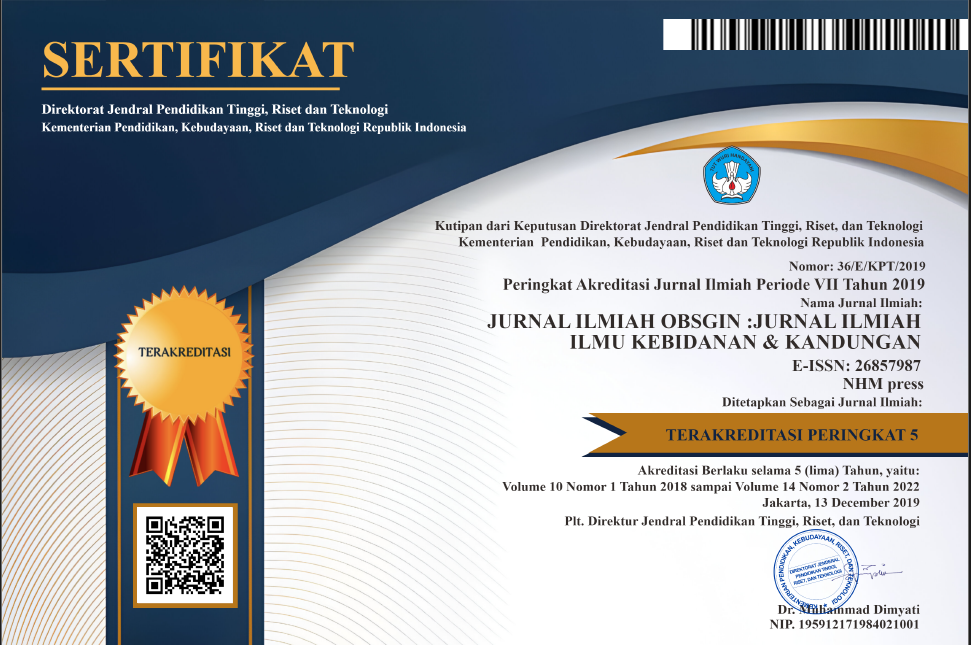PENGARUH PERILAKU STAF TENTANG PENGOBATAN TERHADAP PENYEMBUHAN LUKA PASCA SEKSIO SESAREA
Abstract
The main problem that must be faced, that is wound healing
after surgery. The staff behavior was one of the factors that
support and affect the wound healing process. In reality there
are still mothers with post partum cesarean section wound
healing process not heal the wound base criteria and there are
signs of infection as much as 30%. The purpose of this study
was to analyze the influence of the behavior of the staff about
the treatment and healing of wound healing after cesarean
section in Syarifah Ambami Rato Ebu Bangkalanhospitals.
Design of this study uses analysis with retrospektif approach.
The population are 44 people, samples consist of 40 people with
simple random sampling technique. The independent variable
behavior of the staff, the dependent variable of the wound
healing. Collecting data using questionnaires with chi square
test.
The result showed that mostly of data by category caring staff
behavior as much as 24 respondents (60%) and mostly category
of healed wound healing as much as 24 respondents (60%.The
result of statistical chi square test from two variables shows that
probability values > α is 0,018 < 0,05 indicates influence
between behavior of the staff with the wound healing after
cesarean in Syarifah Ambami Rato Ebu Bangkalan hospitals.
Caring staff behavior that can make the patient
comfortable and feel cared. Patients who feel comfortable and
cared have a lot bit can affect the healing process. So, The
researcher expects following up with counseling that he can get
information about the complaints during experienced the wound
healing process.
References
penelitian suatu pendekatan
praktik, Jakarta: Rieneka Cipta.
Arisanty, Irma Puspita. 2014.
Manajemen Perawatan Luka:
Konsep Dasar, Jakarta: EGC.
Boyle. 2008. Pemulihan Luka,
Jakarta: EGC.
Dedi, Blacius. 2008. Perilaku Caring
Perawat Pelaksana
StudiGrounded Theory. Jurnal
Keperawatan thn MMVIII.
Dyah. 2013. Modul Pengantar
Biostatistik, Mojokerto: Poltekkes
Majapahit.
Harry. 2007. Mekanisme endorphin
dalam tubuh. Abdomen [Online].
Jakarta. Available
http://klikharry.files.wordpres.co
m [Accessed 11 agustus 2016].
Hidayat. 2012. Metode Penelitian
Kebidanan dan Teknik Analisis
Data, Jakarta: Salemba Medika.
Medicinestuffs. 2013. Dehisensi
Luka Operasi Abdomen
[Online]. Jakarta.
Available:http://www.medicines
tuffs.com/2013/12/dehisensiluka-operasi-abdomen.html
[Accessed 17 maret 2016].
Mochtar, Rustam. 2013. Sinopsis
Obstetri: Obstetri Operatif,
Obstetri Sosial, E.d. 3, jilid 2,
Jakarta: EGC.
Morison. 2004. Manajemen Luka,
Jakarta: EGC.
Nova, Elok. 2012. Hubungan Antara
Faktor Usia dengan
Penyembuhan Luka Episiotomi
pada Ibu Nifas. Jurnal Ilmu
Kesehatan thn MMXII.
56
Notoatmodjo. 2010. Metodologi
Penelitian Kesehatan, Jakarta:
Rineka Cipta.
Riyanto, Agus. 2013. Statistik
Deskriptif untuk Kesehatan,
Yogyakarta: Nuha Medika.
Sartika, Nanda. 2011. Konsep
Caring. [Online]. Jakarta.
Available:
http://www.pedoman.news.com
[Accessed 20 juli 2016].
Sarwono. 2005. Ilmu Kebidanan,
Jakarta: Tridasa Printer.
Saryono. 2011. Metodologi
Penelitian Kebidanan DIII, DIV,
S1, dan S2, Yogyakarta: Nuha
Medika.
Sujarweni, Wiratna. 2014.
Metodologi Penelitian
Keperawatan, Yogyakarta: Gava
Media.
Sunaryo. 2004. Psikologi Untuk
Keperawatan, Jakarta: EGC.
Wikipedia. 2016. Bedah Sesar
[Online]. Jakarta. Available:
https://id.wikipedia.org/wiki/Be
dah_sesar [Accessed 17 maret
2016].
Wordpress. 2007. Kepuasan Pasien
Terhadap Pelayanan Rumah Sakit
[Online]. Jakarta. Available:
https://klinis.wordpress.com/2007/12
/28/kepuasan-pasien-terhadappelayanan-rumah-sakit/ [Accessed 3
maret 2016].











